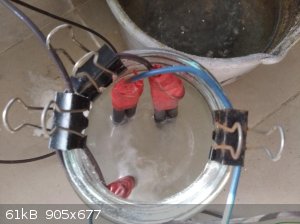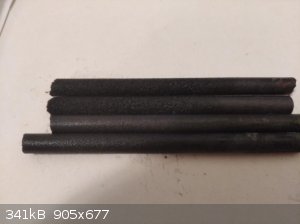mysteriusbhoice
Hazard to Others
  
Posts: 473
Registered: 27-1-2016
Member Is Offline
Mood: Became chemistry catboy Vtuber Nyaa
|
|
graphite anode pH buffered chlorate cell test
doing a test on whether or not graphite can work in a chlorate cell buffered by CaCl2 like my previous post.
electrolyte:
NaCl with added CaCl2 10% as buffer
Current density:
37ma/cm^2
voltage:
5.3v
electrodes:
graphite anode
graphite cathode
https://youtu.be/xJ-px3rNBE8
white insoluble Ca(OH)2 will precipitate on cathode as the cell runs pref using stainless steel for that.
low chloride = errosion will occur as an indicator for end of run.
[Edited on 31-8-2020 by mysteriusbhoice]

[Edited on 31-8-2020 by mysteriusbhoice]
|
|
|
mysteriusbhoice
Hazard to Others
  
Posts: 473
Registered: 27-1-2016
Member Is Offline
Mood: Became chemistry catboy Vtuber Nyaa
|
|
current got too high and some errosion occured will test if this continues
|
|
|
mysteriusbhoice
Hazard to Others
  
Posts: 473
Registered: 27-1-2016
Member Is Offline
Mood: Became chemistry catboy Vtuber Nyaa
|
|
Electrodes after 3 days of running..
slight pitting on one due to uneven current distribution probably due to bad connection causing errosion!!
Other electrode looks pristine!!
efficiency of cell = pretty bad due to low temp 37 Celsius which means lots of escaping chlorine which is obvious by the horrid smell.
the uneven current distribution is the majority cause of the errosion probably due to partial or complete failure of connection as they were just
makeshift and not proper.
One pair of anodes are super pitted while the other has minimal errosion and still shiny and pristine in majority of the spots which shows how
delicate graphite can be since the cell was run assuming they will all recieve 37ma/cm^2 current distribution.
Recommendations when running graphite:
pH control is not that good due to lower temps causing a lot of chlorine to escape so secondary tank with heating would probably solve it but
overcomplicate the design.
Connections must be really good and if not run it at half the max current density at around 20ma/cm^2.

[Edited on 2-9-2020 by mysteriusbhoice]
|
|
|
Alkoholvergiftung
Hazard to Others
  
Posts: 151
Registered: 12-7-2018
Member Is Offline
|
|
You need an stir bar. I had the same problem with higher calciumchloride solutions the top of the cell had an ph of 6 the bottom of 12. I you stir it
the chlorine disolves better and you should have no or very little loses.Oh and the closer the electrodes the better the yield i made some holders and
they are only 5mm apart.
[Edited on 2-9-2020 by Alkoholvergiftung]
|
|
|
mysteriusbhoice
Hazard to Others
  
Posts: 473
Registered: 27-1-2016
Member Is Offline
Mood: Became chemistry catboy Vtuber Nyaa
|
|
Quote: Originally posted by Alkoholvergiftung  | You need an stir bar. I had the same problem with higher calciumchloride solutions the top of the cell had an ph of 6 the bottom of 12. I you stir it
the chlorine disolves better and you should have no or very little loses.Oh and the closer the electrodes the better the yield i made some holders and
they are only 5mm apart.
[Edited on 2-9-2020 by Alkoholvergiftung] |
I dont need to if I just run the cell at 65 Celsius using MMO not graphite!
in that cell the pH remains constant due to turbulence and high temp means solubility of chlorine is very high!!.
The overall current efficiency of that setup is 68% based on yield of NaClO3 and the current running through that setup is 25 amps.
The goal of this experiment is not to make chlorate but to see the effects of pH control conditions on graphite.
|
|
|